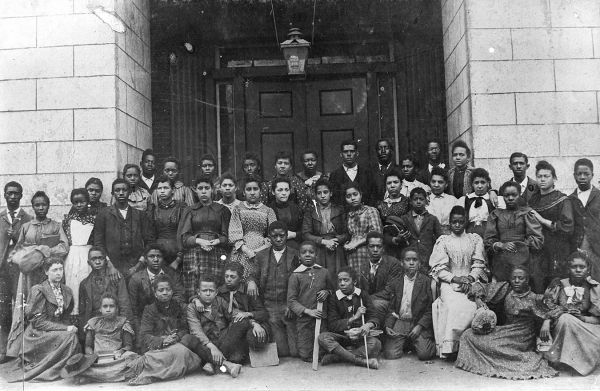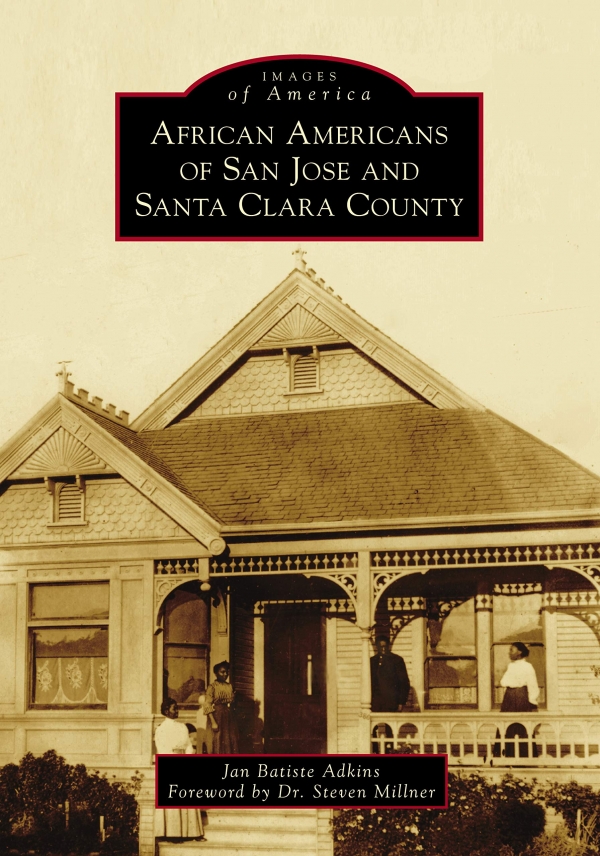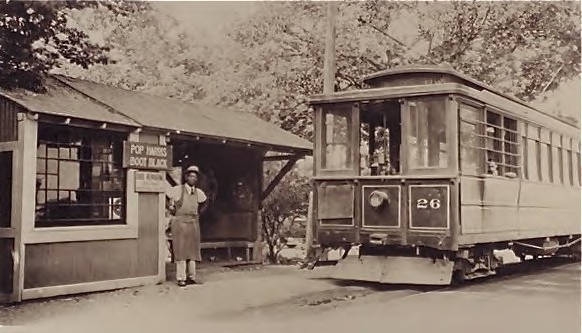Decades before Ronald McDonald House opened its doors as a residence for families of seriously ill children undergoing treatment at Stanford University Medical Center, there was McDonald Home. Named after Sam McDonald, one of the earliest African-American residents to settle in Mayfield (south Palo Alto), it was founded in 1919 as the Stanford Convalescent Home for Underprivileged Children but renamed in 1959 to honor the countless hours McDonald devoted to the home and its children.
McDonald, the grandson of freed Louisiana slaves and superintendent of buildings and grounds at Stanford's stock farm, is among the dozens of early African-American residents in Santa Clara County featured in author Jan Batiste Adkins' newly released book, "African Americans of San Jose and Santa Clara County." The book traces the history of local people of African heritage and their roles in everything from agriculture and technology to politics and education through 185 photos with accompanying text to tell their stories. The book, released on Jan. 28, is part of the "Images of America" series by Arcadia Publishing.
Adkins, an adjunct faculty member and English composition and literature professor at San Jose City College who has been researching local black history for more than a decade, said she hopes her book will shed light on the area's early African-Americans because many of these stories have never been documented.
"This is history that's not readily available," she told the Weekly in a telephone interview last week. "These are hidden histories."
Adkins said she began researching the stories of early black settlers after her students starting asking about the role African-Americans played in local history.
"I didn't have the answers, and when I went to get information, I couldn't find anything," she said. "I didn't have information about where people lived, what kind of opportunities were available or why they came to the area. That prompted me to do the research myself. I wanted to learn and know more ... and that's how it started."
Palo Alto, she said, attracted settlers for many reasons. The first group of African-Americans began settling there just before the turn of the 20th century to work for the Southern Pacific Railroad or on the Stanford campus for the university and its employees.
The earliest of these residents were porters who lived on Fife Avenue in Mayfield near the Stanford train station, which served as a stop between San Francisco and Monterey, Adkins said.
According to Adkins' book, there were nine African-Americans living in the city in 1900, including "Pop Harris," an escaped slave who opened a shoe repair shop on the Stanford campus with his family in 1892. (His son Fran later opened Fran's Market, which operated on the corner of Lytton Avenue.)
Adkins said after World War II, Palo Alto, as well as San Jose, became attractive for different reasons — technology and industry.
"Employers recruited African-Americans from black colleges from around the country to work here," she said. Roy L. Clay Sr., founder of Rod-L Electronic who became known as the "Black Godfather of Silicon Valley," and technologist Frank S. Greene, who developed high-speed semiconductor computer-memory systems at Fairchild Semiconductor R&D Labs, were among those early tech pioneers to settle in Palo Alto.
Adkins said one of the biggest surprises she didn't expect to find while researching Palo Alto was the story of Eichler Homes.
"I kind of assumed there were restricted convenants there because that was the case throughout the Bay Area. That did not surprise me. But what did surprise me were the Joseph Eichler homes."
The Palo Alto real estate developer did not discriminate. He built homes and established nondiscriminatory policies in the 1950s, she said.
"His feeling was if you had the money and you could afford to buy, he would sell," she said.
That's why in the 1950s and '60s many African-Americans (as well as other ethnic groups) moved from their original communities along Ramona, Homer, Channing, Bryant, Cower and Fulton streets into other neighborhoods once restricted to white residents, she added.
Adkins' quest for information has taken her from San Francisco, down to Monterey and finally to Santa Clara Valley, where she discovered that five mulatto families settled in San Jose in 1777 as part of the original pueblo established during the Spanish era.
She published her first book "African Americans of San Francisco," in 2012, followed by "African Americans of Monterey County" in 2015. Adkins said she decided to publish a third book on black pioneers in Santa Clara County after discovering that many of San Francisco and Monterey's early residents had left those areas and migrated to Santa Clara Valley.
"I thought this was so intriguing. I wanted to continue finding out about these people who migrated," she said.
Adkins said she spent countless hours sorting through black newspapers published in San Francisco to piece together details about these early residents. She also found many of their histories on "little sheets of paper" tucked away in boxes stored in libraries and the county archives. For her Santa Clara County research, she tracked down descendants for as many of the area's original families featured in the book as possible. In some cases, she searched for two or three years to locate ancestors, she said.
Adkins said these African-American families came to Santa Clara County during various migration waves.
"Their challenges were about the same, but the reasons for coming were different," she said.
Adkins said she learned that Santa Clara Valley was a very attractive place for early settlers who came out from the Midwest and south looking for new opportunities prior to 1940.
"They wanted to work in agriculture or have their own farms and businesses," she said. "Santa Clara Valley was considered a prime agricultural place."
Adkins said the number of early African-Americans living in Santa Clara County was small, but those pioneers created opportunities for the next generation.
"They overcame great odds of slavery, racial discrimination and economic struggle," she wrote in the book's introduction. "They ultimately developed communities with churches, businesses, schools and and social and cultural organizations ... that still exist throughout Santa Clara County today."
Sam McDonald Park, the 967-acre open space preserve in neighboring San Mateo County created on a portion of property that McDonald bequeathed to Stanford for use as a park for children, is among the monuments that still stand today.
What: Author Jan Batiste Adkins will talk about her new book "African Americans of San Jose and Santa Clara County."
Where: Mitchell Park Community Center, El Palo Alto Room, 3700 Middlefield Road
When: Sunday, March 3, 2-4 p.m.
Cost: Free.
Info: Go to pahistory.org/programs.html.
Adkins discusses her book on an episode of "Behind the Headlines," now available on our YouTube channel and podcast page.





Comments
Ventura
on Feb 22, 2019 at 9:58 am
on Feb 22, 2019 at 9:58 am
from the PA Weekly article...
> (photo caption) Students pose in front of a school for black children. Many local children attended the San Jose School for Colored Children, which operated from 1865 to 1874.
>> California was a so-called 'free state' yet Santa Clara Valley discriminated against people of color by having a separate school for 'colored children' even during the Reconstruction period? The same went for San Francisco except that the Chinese were excluded from attending public schools. So much for ethnic equality. Local white residents were blatantly racist even back then. No different than in the South. But in all fairness, even Boston, MA (a northern area) was racist towards African-Americans. Just ask any black person originally from there.
> "The earliest of these residents were porters who lived on Fife Avenue in Mayfield near the Stanford train station, which served as a stop between San Francisco and Monterey, Adkins said."
>> Others were domestic workers in neighboring homes, working for well-to-do white families. And now Fife is an expensive neighborhood for the PA affluent.
> "I kind of assumed there were restricted convenants there because that was the case throughout the Bay Area. That did not surprise me. But what did surprise me were the Joseph Eichler homes."
> The Palo Alto real estate developer did not discriminate. He built homes and established nondiscriminatory policies in the 1950s, she said."
>> Correct. But how many African Americans did one see living in Eichlers? Most of them eventually settled in the South Palo Alto Ventura neighborhood where they were accepted as PA residents.
> "That's why in the 1950s and '60s many African-Americans (as well as other ethnic groups) moved from their original communities along Ramona, Homer, Channing, Bryant, Cower and Fulton streets into other neighborhoods once restricted to white residents, she added"
>> As the domestic & SP porter jobs diminished, the blacks were eventually forced to relocate & encouraged to seek residency in other 'acceptable' parts of Palo Alto. How many African-Americans reside in Crescent Park, Old Palo Alto & Professorville? Let's get real.
The historian paints too rosey a picture as Palo Alto's African-American residency is only about 10% of the city's population and historically, African-Americans were only accepted/tolerated to perform menial tasks for the wealthier white community.
another community
on Feb 22, 2019 at 2:15 pm
on Feb 22, 2019 at 2:15 pm
> The historian paints too rosey a picture as Palo Alto's African-American residency is only about 10% of the city's population and historically, African-Americans were only accepted/tolerated to perform menial tasks for the wealthier white community.
The same can be said of other minorities in Palo Alto pre-WW2 & into the early 1970s. It was only after their children achieved college educations that things started to change a bit. Before then, civil service provided an alternative as did the medical & dental professions...for some. Hewlett-Packard was an equal-opportunity employer but minorities were never allowed to ascend into the upper management ranks.
Prior to that period, most minorities residing in Palo Alto were employed as laborers, gardeners, domestics or ran service businesses (i.e. dry cleaners/laundry
services, nurseries etc.).
Palo Alto has always been subtle in its racism but if one knew their place, a minority individual could co-exist without hassle.
The racism is still prevalent today & directed towards the increasing number of newer residents from China who are establishing residency in Palo Alto. There's a quiet, unspoken resentment among some but it is restrained by PC considerations & the fact that many of these new residents are far wealthier than many Palo Altans who have been here for awhile.
another community
on Feb 23, 2019 at 10:25 am
on Feb 23, 2019 at 10:25 am
I would also like to see a book written about the contemporary Mexican-Americans who helped build Palo Alto...with their backs as street and construction workers.
Janitorial services at the various office complexes should also be included.
Why is it that recognition primarily goes to certain individuals of certain ethnic backgrounds?
It is like a general getting full or entire credit for winning a battle.
another community
on Feb 23, 2019 at 8:03 pm
on Feb 23, 2019 at 8:03 pm
>>The racism is still prevalent today & directed towards the increasing number of newer residents from China who are establishing residency in Palo Alto. There's a quiet, unspoken resentment among some but it is restrained by PC considerations & the fact that many of these new residents are far wealthier than many Palo Altans who have been here for awhile.
[Portion removed.]
For many wealthy Chinese from overseas, Palo Alto is a very affordable community with excellent public schools & close proximity of high-end shopping.
Palo Alto High School
on Feb 23, 2019 at 9:05 pm
on Feb 23, 2019 at 9:05 pm
[Post removed.]
Another Palo Alto neighborhood
on Feb 24, 2019 at 5:16 pm
on Feb 24, 2019 at 5:16 pm
Middle Easterners have also been overlooked in the contemporary history of Palo Alto.
Upon our arrival to the midpeninsula, we have opened delicatessens, restaurants & liquor stores which contribute to the growing economy of the SF Bay Area.
When will we receive some credit for the efforts we have expended towards enhancing the lives of countless local residents?
Stanford
on Feb 25, 2019 at 12:36 pm
on Feb 25, 2019 at 12:36 pm
Judging by some of the follow-up responses... while it is admirable (as well as significant) that the various contributions & legacies of midpeninsula African Americans have been acknowledged, other ethnic groups are often conspicuous by their absence in historical documentary presentations.
Whether this exclusion is due to ignorance or pervasive racism cannot be established as there will always be deniers along with those who are unaware.
Some might even profess that Leland Stanford was an equal opportunity employer as he had many people of color working for him as laborers on 'the farm' including those of Native California Indian, Mexican & Chinese decent. Whether they were well-paid or hired purely as cheap labor is for the historians to determine & verify.
In any event, wealthy white midpenisulans often looked down on minority peoples as did the white middle & working classes. Palo Alto is no different.
The wealthy Chinese from overseas are changing the residential landscape of Palo Alto & in time, they will have a far larger voice in local politics & school district policy than ever before in the history of this area.
University South
on Feb 25, 2019 at 11:40 pm
on Feb 25, 2019 at 11:40 pm
and we mustn't overlook the vast contribution that the LGBT community has made to the sf bay area as well.
East Palo Alto
on Feb 26, 2019 at 12:22 pm
on Feb 26, 2019 at 12:22 pm
African-Americans also deserve credit for their contributions to the emergence of East Palo Alto as a major black community.
Before their arrival, EPA was predominantly white but unlike Palo Alto, the city welcomed its new residents of color.
East Palo Alto
on Feb 27, 2019 at 2:10 pm
on Feb 27, 2019 at 2:10 pm
> Before their arrival, EPA was predominantly white but unlike Palo Alto, the city welcomed its new residents of color.
An older resident in EPA have told me that East Palo Alto became a predominantly black community because the white residents began leaving en masse when more blacks began moving into the neighborhood.
She even said that at one time EPA was called Nairobi in honer of the capital of Kenya. That speaks volumes in terms of the demographics at the time.
Adobe-Meadow
on Feb 27, 2019 at 2:27 pm
on Feb 27, 2019 at 2:27 pm
The following demographic exit was by many black families when the area transitioned to predominantly Hispanic.
East Palo Alto
on Feb 27, 2019 at 5:29 pm
on Feb 27, 2019 at 5:29 pm
[Post removed.]
another community
on Mar 2, 2019 at 1:56 pm
on Mar 2, 2019 at 1:56 pm
[Post removed.]
another community
on Mar 2, 2019 at 2:32 pm
on Mar 2, 2019 at 2:32 pm
[Post removed.]
Crescent Park
on Mar 2, 2019 at 5:05 pm
on Mar 2, 2019 at 5:05 pm
[Post removed.]
Menlo Park
on Mar 3, 2019 at 1:20 pm
on Mar 3, 2019 at 1:20 pm
> An older resident in EPA have told me that East Palo Alto became a predominantly black community because the white residents began leaving en masse when more blacks began moving into the neighborhood.
Did this lead to EPA's eventual economic decline & lack of progress?
Ventura
on Mar 3, 2019 at 3:43 pm
on Mar 3, 2019 at 3:43 pm
> Did this lead to EPA's eventual economic decline & lack of progress?
Housing prices dropped dramatically during the transition period from white to black residency in EPA & this demographic change was also reflected in property tax revenues which goes to finance infrastructure expenditures.
Less money coming in = less civic improvements including adequate funding for law enforcement.
As a result, the neighborhood got run down & crime prevention became more difficult to maintain.